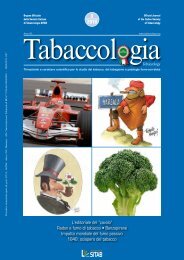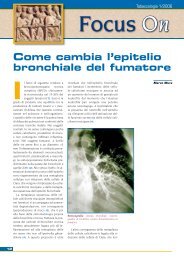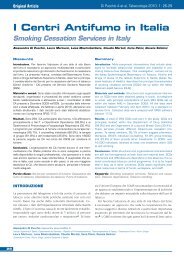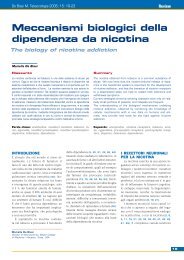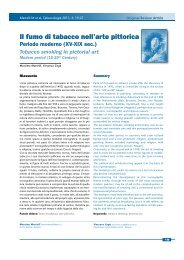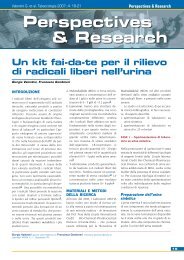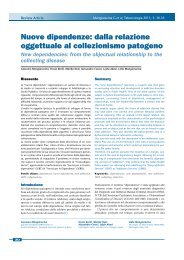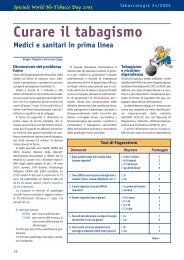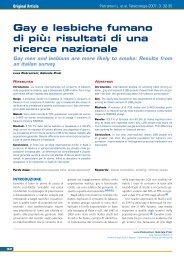Scarica n. 3/2003 - Società Italiana di Tabaccologia
Scarica n. 3/2003 - Società Italiana di Tabaccologia
Scarica n. 3/2003 - Società Italiana di Tabaccologia
You also want an ePaper? Increase the reach of your titles
YUMPU automatically turns print PDFs into web optimized ePapers that Google loves.
Original Articles<br />
Stu<strong>di</strong>o osservazionale sull'uso <strong>di</strong> un integratore<br />
amino-fitoterapico nella cessazione dell'abitu<strong>di</strong>ne tabagica<br />
Osservational study on the use of a aminoacids & phytotherapic<br />
integrator in smoking cessation<br />
B. Tinghino, V. Zagà, P. Gremigni, L. Tosto, M. Muru, L. Braga, G. Mangiaracina, C. Chiamulera<br />
Riassunto<br />
INTRODUZIONE. Diverse molecole <strong>di</strong> origine vegetale sono potenzialmente utili per ridurre l'intensità dei sintomi astinenziali<br />
correlati alla <strong>di</strong>sassuefazione da fumo o per contrastare gli effetti dannosi che il tabacco esercita sull'organismo. Si tratta <strong>di</strong><br />
sostanze ad azione in<strong>di</strong>retta, che da sole non possono essere validate col significato <strong>di</strong> terapia specifica nella <strong>di</strong>pendenza nicotinica,<br />
ma che possono utilmente intervenire con funzione complementare avendo un effetto ansiolitico, <strong>di</strong>gestivo, antiossidante<br />
ed epatoprotettore.<br />
MATERIALE E METODI. Le osservazioni qui riferite si riferiscono ad un campione <strong>di</strong> 80 soggetti, <strong>di</strong> cui 65 trattati con un integratore<br />
amino-fitoterapico e 15 non trattati.<br />
RISULTATI. Tra il gruppo <strong>di</strong> soggetti trattati si e’ osservata una tendenza, non significativa, ad una più alta percentuale <strong>di</strong> <strong>di</strong>sassuefazione<br />
testata ad un mese dalla fine del trattamento (84,6% vs 73,3%), ed in particolare un in<strong>di</strong>ce <strong>di</strong> sod<strong>di</strong>sfazione (autovalutato)<br />
elevato per quel che riguarda l'efficacia sul piano ansiolitico (100%), sul tono dell'umore (98%), nonché sul "buon funzionamento"<br />
dell'intestino (98%).<br />
CONCLUSIONI. La scarsa numerosità del campione in<strong>di</strong>ca tuttavia la necessità <strong>di</strong> stu<strong>di</strong> più ampi.<br />
Parole chiave: <strong>di</strong>sassuefazione dal fumo, sostanze fitoterapiche, sindrome d’astinenza.<br />
Abstract<br />
BACKGROUND. Several vegetal molecules are potentially useful for the reduction of tobacco withdrawal symptoms and,<br />
moreover, for the protection from harmful effects of tobacco.These substances have an in<strong>di</strong>rect effect which cannot currently<br />
be validated as specific therapy against nicotine dependence. However, these vegetal substances may be useful as coadjuvants<br />
of smoking cessation because of their anxiolytic, <strong>di</strong>gestive, anti-oxidant and hepatoprotective effects.<br />
MATERIALS AND METHODS. Our fin<strong>di</strong>ngs are from a sample of 80 subjects, 65 treated with aminoacids and phytotherapic integrator<br />
and 15 not-treated.<br />
RESULTS. It has been observed a not significant trend toward a greater smoking cessation rate in treated subjects (84.6% vs.<br />
73.3 in not-treated subjects). High self-evaluated index of satisfaction with the therapy has been described by treated subjects<br />
on anxiety (100%), mood (98%) and gastroenteric functions (98%).<br />
CONCLUSIONS. The limited sample size suggests further investigations on these vegetal substances.<br />
Key words: smoking cessation, phytotherapic substances, withdrawal syndrome.<br />
Premessa<br />
Il fatto che alcuni estratti vegetali possano<br />
intervenire sui "<strong>di</strong>sturbi correlati" alla<br />
astinenza da nicotina pone le basi per<br />
una maggiore attenzione verso il mondo<br />
della fitoterapia, soprattutto se è possibile<br />
ottenere l'efficacia pagando un basso<br />
contributo <strong>di</strong> effetti collaterali e ottenendo<br />
una buona compliance da parte dei<br />
18<br />
Biagio Tinghino (btinghi@tin.it)<br />
Segretario SITAB, SERT Monza<br />
Vincenzo Zagà<br />
Presido Pneumotisiologia - AUSL città <strong>di</strong> Bologna<br />
Vicepresidente SITAB<br />
Tinghino B. et al, <strong>Tabaccologia</strong> <strong>2003</strong>; 3: 18-22<br />
pazienti. (1)Una rilevante percentuale <strong>di</strong><br />
pazienti (fino al 50%, nell'esperienza riferita<br />
da Mangiaracina e coll.) peraltro<br />
rifiuta cure farmacologiche e si rivolge a<br />
terapie "alternative". In Italia, secondo<br />
stime dell'Istituto Superiore <strong>di</strong> Sanità (2),<br />
nel 1999 sono stati spesi 559 miliar<strong>di</strong> <strong>di</strong><br />
lire per il consumo <strong>di</strong> fitoterapici, con<br />
una spesa pari al 16,5% <strong>di</strong> quella euro-<br />
Paola Gremigni<br />
Psicoterapeuta Professore a contratto Teorie e tecniche<br />
dei test- Facoltà <strong>di</strong> Psicologia Università <strong>di</strong> Bologna<br />
Luigi Tosto, Marinella Muru<br />
Centro Antifumo-Pneumologia Osp. Bellaria<br />
AUSL città <strong>di</strong> Bologna<br />
pea. Da qui la necessità <strong>di</strong> stu<strong>di</strong> che possano<br />
fornire un supporto esperienziale<br />
razionale all'uso <strong>di</strong> prodotti che trovano<br />
comunque una collocazione nel bagaglio<br />
del tabaccologo. Dalla stessa considerazione<br />
<strong>di</strong>scende la necessità <strong>di</strong> una<br />
adeguata formazione degli operatori<br />
nell'ambito dell'uso <strong>di</strong> supporti complementari,<br />
in modo da muoversi adeguata-<br />
Giacomo Mangiaracina<br />
Presidente SITAB, Coor<strong>di</strong>natore Area Tabagismo LILT<br />
Christian Chiamulera<br />
<strong>Società</strong> <strong>Italiana</strong> <strong>di</strong> <strong>Tabaccologia</strong>-SITAB<br />
Università degli stu<strong>di</strong> <strong>di</strong> <strong>di</strong> Verona



